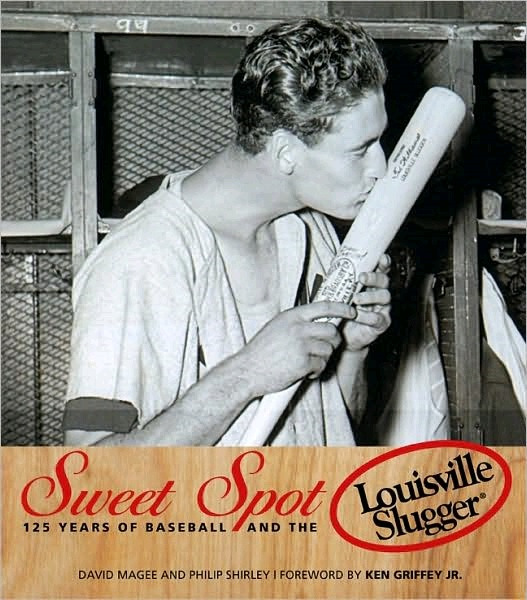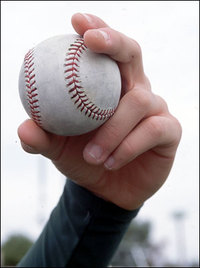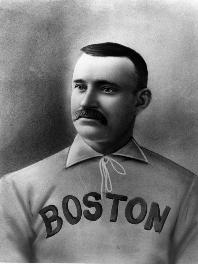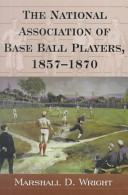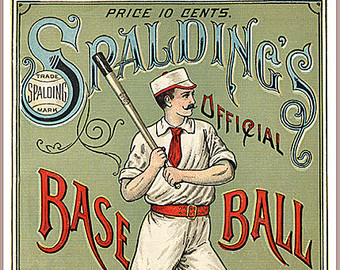The Knickerbockers of New York had published their rules in the mid-1840s, and these were influential, but they left a good deal of ambiguity for readers trying to organize and play a contest. Concerning the actual events on the field of play, they read:
The bases shall be from “home” to second base, forty-two paces; from first to third base, forty-two paces, equidistant.
The game to consist of twenty-one counts, or aces; but at the conclusion an equal number of hands must be played.
The ball must be pitched, not thrown, for the bat.
A ball knocked out of the field, or outside the range of the first and third base, is foul.
Three balls being struck at and missed and the last one caught, is a hand-out; if not caught is considered fair, and the striker bound to run.
If a ball be struck, or tipped, and caught, either flying or on the first bound, it is a hand out.
A player running the bases shall be out, if the ball is in the hands of an adversary on the base, or the runner is touched with it before he makes his base; it being understood, however, that in no instance is a ball to be thrown at him.
A player running who shall prevent an adversary from catching or getting the ball before making his base, is a hand out.
Three hands out, all out.
Players must take their strike in regular turn.
All disputes and differences relative to the game, to be decided by the Umpire, from which there is no appeal.
No ace or base can be made on a foul strike.
A runner cannot be put out in making one base, when a balk is made on the pitcher.
But one base allowed when a ball bounds out of the field when struck.
Considering that the current Official Baseball Rules, 2015 Edition is about 120 pages long, there must circumstances and nuances that forced individual players and clubs to adopt their own set of guidelines. This was especially true of the pitcher and his responsibilities. The Knickerbockers only say that “The ball must be pitched, not thrown, for the bat.”
Thus, pitching distance and other restrictions on the pitcher probably fluctuated from club to club and perhaps season to season or game to game and from umpire to umpire. This probably wasn’t that great of an issue as clubs played most of their contests within their own organization. But when interclub matches took place, these and other rules for that contest had to be hashed out beforehand, a process that was naturally contentious.
After the 1856 season, the Knickerbockers of New York, the oldest club in existence at that point, called for a meeting to standardize the rules of the game and to further promote the sport itself in the New York area. The clubs that met formed the National Association of Base Ball Players, NABBP. This organization, more or less, oversaw the game until the era of the professional leagues starting in 1871.
The number of clubs within the NABBP varied widely throughout its existence but it is safe to say that during the NABBP era its particular form of baseball, the New York Game, became the dominate style, strategy and rules of the sport throughout the country.
The spreading and adopting of the New York style of play did not take place at one particular moment in history; it was a haphazard and sporadic process. Many other forms of the sport were played before the universal melding under the New York rules took place. The only rules and regulations that will be examined here are those of the New York Game.
1854
On 1 April 1854, three Manhattan clubs (Knickerbockers, Gothams and Eagles), who faced each other maybe once or twice a year, agreed to a uniform set of rules. The written limitations on pitching are meager and thus a bit unclear to today’s reader:
♦ Pitching distance is to be “not less than 15 paces,” perhaps meaning no less than 37.5’ at 30 inches a pace.
♦ The ball must be pitched, and not thrown, for the bat.
These rules, as meager as they are, answered at least one looming question – where was the pitcher to be positioned. Presumably, it was understood that he stood along the imaginary line between second base and home base. These are the first and only formal restrictions on the pitcher.
(In truth, how the pitcher delivered the ball and where exactly he stood may not have been important issues at the time. Today, we view the pitcher as a central figure in the game, perhaps the key figure. In the 1850s, his function was predominantly to get the fun started.)
It will take another four decades for officials to finally decide on the proper pitching distance and accepted methods of delivery. The following shows baseball’s progress to define these issues:
1857
Home plate and the pitcher’s plate were circular iron plates embedded in the ground and painted or enameled white. These plates are expected to be imbedded in the ground at ground height.
PITCHING DISTANCE AND PITCHER’S AREA
Pitchers line 12’ long, 45’ from home plate (presumably the iron plate is located just behind the line at its center)
________o________ (12’)
45’ to home
The ball must be released by the pitcher behind the line.
Considering the dangers of stepping on an iron plate, especially when damp, the pitcher probably avoided landing on the plate during his delivery.
(It should be noted that there is minor confusion in understanding the early rules in relation to how the pitching distance was calculated. That is from the front of home plate, the middle or the back. This confusion continues for many of the early years until the marking settles at the middle of the eventually diamond-shaped plate.)
Assume that pitching distances and the pitcher’s area remains the same until a new diagram is provided.
PITCHING REGULATIONS
The ball must be pitched, not jerked or thrown to the bat, and whenever the pitcher draws back his hand, with the apparent purpose or pretension to deliver the ball, he shall so deliver it. The pitcher must deliver the ball as near as possible, over the center of the home base, and must have neither foot in advance of the line at the time of delivering the ball, and if he fails in either of these particulars, then it shall be declared a balk.
When a balk is made by the pitcher, every player running the bases is entitled to one base without being put out.
Basically:
♦ The wrist is not supposed to be snapped or twisted (think more along the lines of a bowler with a stiff wrist than a current fast-pitch softball pitcher).
♦ The pitcher cannot fake a pitch to home or otherwise windup to confuse the batter.
♦ The pitcher’s feet may not cross the line and his intention must be to deliver the ball over the center of home plate.
♦ If the pitcher does not fulfill these requirements, there is a penalty.
PITCHING STYLE
It is important to note:
♦ The responsibility of the pitcher is to get the ball in play.
♦ The pitcher is there as a peaceful combatant to help put the ball into play for the fielders.
♦ The pitcher did not hold the status in the sport that he does today.
♦ The ball is pitched underhand, with a perpendicular arm angle to the ground.
♦ It’s assumed that the pitcher gets a bit of a running start and that is where his velocity is supposed to come from, not by snapping the wrist.
♦ The pitcher should not jerk his wrist as to put any form of what we might call “English” on the ball.
By the late 1850s and certainly the early 1860s, pitchers were increasingly taking liberties to gain velocity and utilizing methods deemed by many as trickery. Thus, the NABBP felt compelled to alter their pitching requirements in 1863. They had matched verbatim from 1857 through 1862.
1858
On 10 September 1858, an umpire, Doc Adams, made the first called third strike ruling. Previously the batter was only penalized for swinging and missing. Presumable, the new rule, enacted for 1858, was created to penalize batters who were too selective – choosing to swing at only the pitches they liked. Though included among the rules, the called third strike was rarely made prior to 1866.
1863
PITCHING DISTANCE AND PITCHER’S AREA
♦ A pitcher’s box is introduced, 3’ in length (extending towards second base) and 12’ in width (running from first to third base)
♦ The front of the box is still 45’ from home.
♦ Two iron plates are utilized, one at front of box and one at back, both centered. (not shown)
12’
3’
45’ to home plate
PITCHING REGULATIONS
♦ The pitcher must stand within the lines [of the pitcher’s box].
The introduction of a box is obviously a method to hem pitchers in and limit their roving. By making the box only 3’ deep, their running start is limited. Presumably, this is an attempt to limit velocity. With a pitcher’s box, the pitcher may not step over the front line during his delivery.
♦ Should the pitcher repeatedly fail to deliver to the striker fair balls, for the apparent purpose of delaying the game, or for any other cause, the umpire, after warning him, shall call one ball, and if the pitcher persists in such action, two and three balls; when three balls shall have been called, the striker shall be entitled to the first base; and should any base be occupied at that time, each player occupying them shall be entitled to one base without being put out.
This rule was written to combat the increasingly peskiness of pitchers. It had come into vogue for pitchers to move the ball around, presumably up and down and in and out. Also, pitchers were at times throwing at or near the batter to keep him off balance and trying to get them to chase outside pitches.
By seeing this regulation, it’s apparent that pitching was beginning to evolve into taking a predominant role in the proceedings. Pitchers no longer see themselves – and hadn’t since the late 1850s – as mere delivery vehicles to putting the ball in play. Furthermore, this is essentially the first attempt at a pitch count – too many balls and the batter is awarded first base.
♦ The ball must be pitched, not jerked nor thrown to the bat; and whenever the pitcher draws back his hand, or moves with the apparent purpose or pretension to deliver the ball, he shall so deliver it, and he must have neither foot in advance of the front line or off the ground at the time of delivering the ball; and if he fails in either of these particulars, then it shall be declared a balk.
This reads basically the same as 1857-1862.
PITCHING STYLE
Wrist snapping had been taking place probably since the late 1850s, garnering more and more velocity for the pitcher. Formal rules had been developed to force the pitcher to “pitch” not “throw” or “jerk” the ball. Pitch means tossing with a stiff wrist, horseshoe-style.
Other rules like creating a box to pen-in the pitcher and ceding first base to a batter who didn’t get decent pitches to hit were meant to keep the game predominantly about hitting and fielding.
Nonetheless, it was always difficult to read the pitcher’s intention and control his body movements, some of which could be quite subtle. As the 19th century progresses, pitcher’s will increasingly use their guile to thwart the restrictions. It will become commonplace to do so and thus difficult to modify or regulate.
Arguments would ensue and both teams would take their advantages where possible. This in turn created a laxness in umpires (who were only these to solve disputes, enforce rules at their will), many of whom would rather let the men hash it out and allow the game play on than be a part of ceaseless arguments and stressful confrontations.
Gradually, pitchers would change how the game was played. Yes, in so doing animosity and arguments about the nature of the game abound. Pitchers and pitching became lightening rod topics, probably from the earliest days of interclub competition.
Yet in the end, arbitrary, ill-defined, unwritten, unenforced and unenforceable rules and their haphazard applications on the field – mixed with the strong will of pitchers who increasingly viewed themselves at the forefront of the competition – were hard to adjudicate. Pitchers would eventually take liberties little by little until most of the restrictions against their delivery methods were abandoned by the end of the century.
1864
Pitchers are expected to deliver their pitch with both feet on the ground. Again, this is probably another attempt to limit pitchers’ velocity – especially as pitching became a more specialized job attracting specialists who were particularly good at it.
1866
PITCHING DISTANCE AND PITCHER’S AREA
Pitching box made one foot deeper.
12’
4’
45’ to home plate
1867
PITCHING DISTANCE AND PITCHER’S AREA
Pitching box cut in half from left to right to 6’.
6’
4’
45’ to home plate
PITCHING REGULATIONS
The following points are added or amended to the rules:
♦ The pitcher must stand within the lines, and must deliver the ball as near as possible over the center of the home base, and fairly for the striker.
♦ All balls delivered by the pitcher, striking the ground in front of the home base, or pitched, striking the batsman, or pitched to the side opposite to that which the batsman strikes from, shall be considered unfair balls.
♦ The ball shall be considered jerked, in the meaning of the rule if the pitcher’s arm touches his person when the arm is swung forward to deliver the ball; and it shall be regarded as a throw if the arm be bent at the elbow, at an angle from the body, or horizontally from the shoulder, when it is swung forward to deliver the ball A pitched ball is one delivered with the arm straight, and swinging perpendicularly and free from the body.
Fair (strikes) and unfair (balls) pitches are starting to be defined. And obviously ‘unscrupulous’ pitchers are ignoring the “over the center of home base” guideline – tossing the ball at the batter, into the ground and outside into the other batter’s box.
Note that a hit-batsman is only awarded a ball, not first base.
The definition of a “jerk” arises.
It’s clear that baseball officials are now very concerned with the release point of the ball and the arm angle it is delivered at. The pitcher is expected to pitch perpendicular to the ground (underhand) and cannot jerk his arm towards his body or bend his elbow. A legal pitch is one “delivered with the arm straight, and swinging perpendicularly and free from the body.”
Presumably, pitchers had been taking liberties with their release point, allowing it to creep up towards hip height instead of below it.
The balk rule is further clarified:
♦ When a balk is made by the pitcher, every player running the bases is entitled to one base, without being put out.
♦ The striker shall be considered a player running the bases as soon as he has struck a fair ball.
♦ Any ball, delivered by the pitcher, on which a balk or a ball has been called, shall be concerned dead and not in play until it has been settled in the hands of the pitcher, while he stands within the lines of his position; and no such ball, if hit, shall put the striker out.
The batter is not a runner until he has placed the ball in play.
1868
Pitchers are no longer required to make their delivery with both feet on the ground.
1869
Home plate is now a 12” square with one flat side facing the pitcher.
1871
Eighteen Seventy-One denotes the beginning of professional league baseball.
The 12”-home plate is rotated with a point now facing the pitcher. This widens the plate from the pitcher’s perspective to 16.97”. (Note that the current 17”-home plate adopts its measurement from this.)
PITCHING DISTANCE AND PITCHER’S AREA
The pitcher’s box is now square.
6’
6’
45’ to home plate
PITCHING REGULATIONS
The pitcher’s release point must be below the hip and he is still expected to delivery with a straight arm, perpendicular to the ground.
Batters now call for a high (waist to shoulders) or low (waist to forward knee) pitch. Thus, the strike zone is coming more and more into focus. Previous written regulations only stated that that the ball had to pass over the center of the plate. (Presumably, this was adjudged from the knees to the shoulders.)
The number of ball and strikes required for a base on balls or strikeout, respectively, will swing wildly for much of the rest of the century.
1872
Underhand throwing was legalized in 1872. It is unclear if this in fact legalized wrist snapping or pitching with a bent elbow or both. The release point is still expected to be below the hip.
Some pitchers, trying to get an advantage during the era, would hike their pants up high in effect allowing them to pitch sidearm as the hip/waist of their pants masked their actual hip/waist height.
1875
Home plate is to reside entirely in foul territory.
1876
Home plate is moved back into fair territory and the pitching distance is calculated from the back of home plate.
1877
PITCHING DISTANCE AND PITCHER’S AREA
Pitching distance is to be calculated from the center of home plate.
The front and back center pitcher’s plates are removed. Now there are 6” square markers (stone or iron), placed at ground level in each corner of the box.
1879
PITCHING DISTANCE AND PITCHER’S AREA
The pitcher’s box is still square, though smaller.
4’
4’
45’ to home plate
PITCHING REGULATIONS
Pitchers are not allowed to turn their backs to the batter during their delivery.
If in the umpire’s opinion a pitcher intentionally hits a batter, the pitcher could be fined between $10 and $50. However, in doing so the batter is still only awarded a ball not first base. The ball was considered dead with no base runners advancing.
1881
PITCHING DISTANCE AND PITCHER’S AREA
The distance from home plate to the front line of the pitcher’s box is increased by 5’ to 50’.
The box dimensions are amended as well.
6’
4’
50’ to home plate
1883
PITCHING REGULATIONS
Pitchers may now legally release the ball above their hip as long as it is below their shoulder. Pitchers had been pushing the hip limit since the mid-1870s.
1884 AMERICAN ASSOCIATION
PITCHING DISTANCE AND PITCHER’S AREA
The American Association, a major since 1882, adopted a deeper box than the National League in 1884.
4’
6’
50’ to home plate
PITCHING REGULATIONS
“If a Batsman be solidly hit by a ball from the Pitcher when he evidently cannot avoid the same, he shall be given his base by the umpire as a penalty.”
This is the first league to award first base to a hit-batsman. If the umpire ruled that the batter did not try to get out of the way or was merely grazed by the ball, the batter was awarded only a ball, not first base.
1884 NATIONAL LEAGUE
PITCHING REGULATIONS
The National League permanently eliminated all restrictions on release point. Pitchers may now deliver the ball overhand, above the shoulder.
This, combined with varying pitch repertoires and changes to the pitching distance will fundamentally alter the makeup of pitching staffs. Typically, a club only needed one pitcher and an occasional substitute through the 1870s. At least two regular starters would be needed in the 1880s, with that number expanding to 3 or 4 in the 1890s.
1885 NATIONAL LEAGUE
PITCHING REGULATIONS
Pitchers must keep both feet on the ground during delivery.
1885 AMERICAN ASSOCIATION
At a meeting on 7 June 1885, American Association officials adopted the use of a rubber home plate.
PITCHING REGULATIONS
At that meeting, they also joined the National League in eliminating release point restrictions.
The American Association revised its hit-batsman rule – eliminating the requirement that the batter had to be hit “solidly.”
1886 NATIONAL LEAGUE
PITCHING DISTANCE AND PITCHER’S AREA
The National League adopted a deeper box in 1886.
4’
7’
50’ to home plate
PITCHING REGULATIONS
National League pitchers no longer have to keep both feet on the ground when delivering.
1886 AMERICAN ASSOCIATION
PITCHING DISTANCE AND PITCHER’S AREA
The American Association changed their pitcher’s box size for 1886.
7’
4’
50’ to home plate
1887
For the 1887 season, the National League and American Association decided to adopt a common set of rules.
Each league adopted the rubber home plate, still a 12” square with points facing the pitcher and catcher.
PITCHING DISTANCE AND PITCHER’S AREA
They compromised on the depth of the pitcher’s box. The National League agreed to shrink it by 1.5’ (7’ to 5.5’) and, likewise, the American Association deepened it by 1.5’ (4’ to 5.5’)
4’
5.5’
50’ to home plate
The pitchers must now affix their back foot to the back line of the box, effectively setting their back foot at 55’6” from home plate. (It is unclear why with a fixed back foot that a box is still required.)
The 50’-distance is measured to the center of home plate.
PITCHING REGULATIONS
Other regulations adopted:
♦ The pitcher must take a stance as to face the batter.
♦ The back foot must remain planted on the back line of the box.
♦ The front foot can only be raised during delivery of the pitch.
♦ The pitcher must hold the ball in front of the body in sight of the umpire.
♦ The pitcher must reset after feigning to throw to a base.
♦ Batters are no longer able to call for high or low pitches. This sets the strike zone upper and lower limits at the shoulders and knees, respectively.
♦ Batters are awarded first base when hit by a pitch unless the umpire believed the batter did not get out of the way. Various circumstances regarding he batter’s motives in getting hit would be argued for another decade. For example, batters started to let the ball graze their hands or forearms leading to a rule in 1892 disallowing hit by pitches to the hands and forearms for several years.
1889
The balls and strikes allow finally settled at 4 and 3, respectively.
1890 PLAYERS LEAGUE
Labor/management strife resulted in the formation of a third major league, the Players League, in 1890. It last one season.
PITCHING DISTANCE AND PITCHER’S AREA
4’
6’
51’ to home plate
The 51’-distance is measured to the middle of home plate. At some unknown date during the season the distance to home plate fell to 50’.
PITCHING REGULATIONS
The Players League adopted the same pitching restrictions as set by the National League and American Association in 1887.
These regulations effectively placed the pitcher’s back foot 57’ from home plate. This was lowered to 56’ at some point as noted above.
1893
The National League and American Association merged after the 1891 season officially forming the cumbersomely-named National League and American Association of Professional Baseball Clubs. It was almost immediately just referred to as the National League like we do today.
PITCHING DISTANCE AND PITCHER’S AREA
The pitching box was eliminated for the 1893 season and replaced by a 12” by 4” rubber like we’re familiar with today.
The distance of that rubber – the place where the pitcher sets his back foot – was pushed back 5’, setting the distance at the 60’6” we recognize today.
A rule was also added allowing the rubber to be raised but with no specific height restrictions. This, for the first time, permits the pitcher’s mound.
(Though there is no longer a pitcher’s box, the verbiage is still in use today to refer to the general area of the pitcher’s station and other connotations.)
1895
PITCHING DISTANCE AND PITCHER’S AREA
The pitcher’s rubber is enlarged to the current 24” by 6”.
PITCHING REGULATIONS
For the first time a foul ball is called as a strike. However, that only applies to ones nicked backwards. To offset this compromise, bat barrels are widened to 2.75”.
PITCHING STYLE
During the 1890s, pitchers are increasingly scuffing, marring and cutting the baseball prior to delivery.
1898
PITCHING REGULATIONS
A pitcher must now have the ball in his possession if he steps onto the rubber with men on base.

